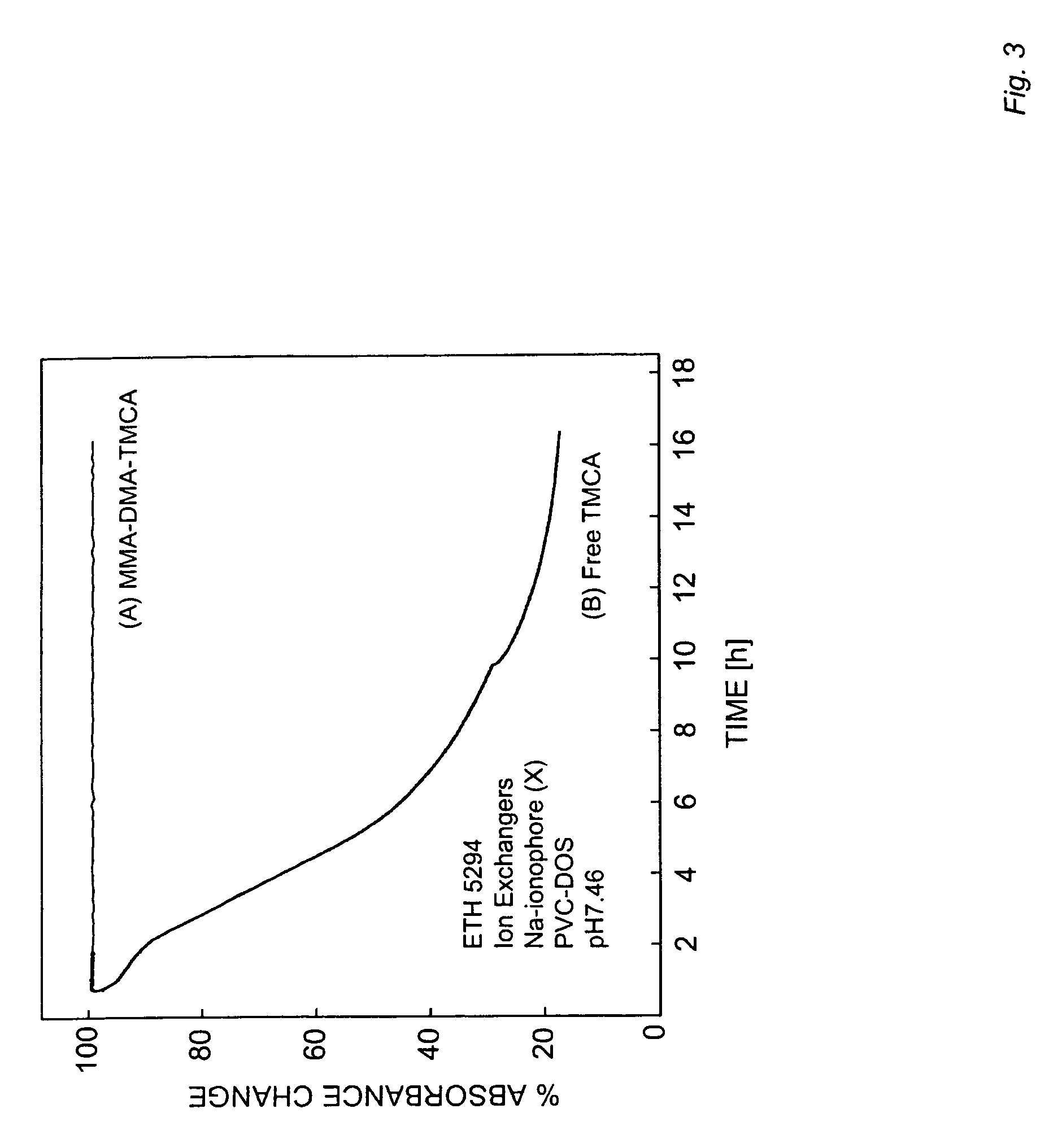Ion-detecting sensors comprising plasticizer-free copolymers
a technology of ion sensors and copolymers, applied in the field of detecting target ions in samples, can solve the problems of unsubstituted tetraphenylborate, the practical limit of synthesizing ionophores and plasticizers with longer alkyl chains, and the move of modern ion sensors towards drastic miniaturization
- Summary
- Abstract
- Description
- Claims
- Application Information
AI Technical Summary
Benefits of technology
Problems solved by technology
Method used
Image
Examples
example 1
Synthesis of Trimethylammonium 2-carborane ethylacrylate (TMCA)
[0075]Preparation of I(CH2)2OTBS (1): To a solution of 2-iodoethanol (3 g, 17 mmol) and imidazole (1.74 g, 25 mmol) in 20 mL anhydrous dichloromethane was added TBSCl (2.82 g, 18.7 mmol). The mixture was stirred at room temperature overnight (12 hours). The reaction mixture was washed with water (2×10 mL), brine (10 mL) and dried over Na2SO4. Removal of the solvent afforded pure product I(CH2)2OTBS (1) (5.6 g, 98% yield, MW: 286.02).
[0076]Preparation of [Me3NH][TBSO(CH2)2—CB11H11] (2): n-Butyllithium (5.5 mmol) was added to a solution of [Me3NH][closo-CB11H12] (0.2 g, 1 mmol) in 15 mL anhydrous THF at 0° C. under N2. The mixture was brought to room temperature and stirred for 1 hour. Compound 1 (0.372 g, 1.3 mmol) in 3 mL THF was added dropwise in a period of 5 min. After the reaction was stirred at room temperature for 15 hour, the solvent was removed. Me3NHCl (6 mmol) in 10 mL water was added to the residue. A pale yel...
example 2
Polymer Synthesis
[0079]All polymers were synthesized via thermally initiated free radical solution polymerization. The amount of methyl methacrylate and n-decyl methacrylate used was the same as reported previously.23 For polymers containing grafted Ca2+-selective ionophores, 5 wt % AU-1 was used. For polymers containing grafted cation-exchanger, 2 wt % TMCA (50 mg, 66 mmol / kg) was used. Calculated amounts of MMA (0.48 g) and DMA (1.97 g)23 were added to 5 mL of dry benzene for AU-1 or ethyl acetate for TMCA. The solution was purged with N2 for 10 min before adding 5.1 mg of AIBN. The homogeneous solution was continuously stirred and the temperature was ramped to 90° C., which was maintained for 16 hours. After the reaction was complete, the solvent was evaporated and the polymer redissolved in 10 mL of dioxane. Aliquots of polymer solution (2 mL) were added to 100 mL of distilled water under vigorous stirring. The white precipitate was collected and dissolved in 25 mL of dichlorome...
example 3
ISE Membrane Preparation and Potentiometric Measurements
[0080]Ionophore-free ISE membranes were prepared by dissolving 10 wt % MMA-DMA polymer with grafted TMCA, 90 wt % PVC and plasticizer (DOS or NPOE) (1:2) to give a total cocktail mass of 140 mg in 1.5 mL of THF.
[0081]Nitrite selective membranes contained 10 mmol / kg Nitrite-ionophore I, 10 wt % MMA-DMA polymer with grafted TMCA, 90 wt % PVC and NPOE (1:2) to give a total cocktail mass of 140 mg in 1.5 mL THF.
[0082]For the plasticizer-free membrane with grafted calcium ionophore AU-1 and grafted ion-exchanger TMCA, the cocktail contained 35 mg MMA-DMA-AU-1, 30 mg MMA-DMA-TMCA and 75 mg blank MMA-DMA polymer in 1.5 mL THF.
[0083]Cocktails were poured into glass rings (2.2 cm i.d.) affixed onto glass microscope slides. The solvent was evaporated overnight to give a transparent membrane. The plasticizer free MMA-DMA membrane was soaked in water for 1 hour and carefully peeled from the glass slide with a scalpel. The membranes contain...
PUM
| Property | Measurement | Unit |
|---|---|---|
| Tg | aaaaa | aaaaa |
| diameter | aaaaa | aaaaa |
| diameter | aaaaa | aaaaa |
Abstract
Description
Claims
Application Information
 Login to View More
Login to View More - R&D
- Intellectual Property
- Life Sciences
- Materials
- Tech Scout
- Unparalleled Data Quality
- Higher Quality Content
- 60% Fewer Hallucinations
Browse by: Latest US Patents, China's latest patents, Technical Efficacy Thesaurus, Application Domain, Technology Topic, Popular Technical Reports.
© 2025 PatSnap. All rights reserved.Legal|Privacy policy|Modern Slavery Act Transparency Statement|Sitemap|About US| Contact US: help@patsnap.com



